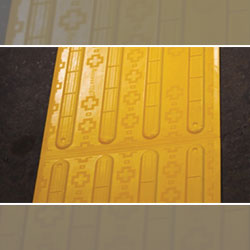









Navigating through public spaces can be challenging for individuals with visual impairments. Having proper wayfinding solutions in place is crucial to ensure accessibility and safety for the visually impaired. Tactile wayfinding uses specialized textures and indicators to guide users and provide important spatial information non-visually through the sense of touch.
As per accessibility legislation in Canada, implementing compliant tactile wayfinding solutions in public spaces is a legal obligation. This guide will explore what tactile wayfinding entails, how it helps the visually impaired, types of solutions and standards for optimal implementation. Read out to know:
Tactile wayfinding utilizes standardized ground surface textures comprising raised bars or indicators installed in walking areas. These tactile cues serve to outline paths of travel and key points like amenities, exits, and turnings through distinctive patterns that can be felt underfoot or with a cane.
There are two main purposes tactile wayfinding serves:
Well-executed tactile wayfinding enables visually impaired individuals to navigate safely and independently within environments by providing physical directional prompts detectable through touch.
Thoughtfully implemented tactile wayfinding confers several advantages for enhancing accessibility:
There are multiple options available when specifying tactile wayfinding solutions:
These are installed on existing hard surfaces using adhesive. It is ideal for retrofit projects with no demolition needed.
These are installed directly into freshly poured concrete. It is suited for new construction. Provide permanent tactile guidance.
Discrete bars screwed into existing surfaces. It is for smaller-scale applications.
Uses glow-in-the-dark photoluminescent strips. It provides illumination in the darkness.
Based on factors like setting, foot traffic, visibility needs and budget, appropriate solutions can be adapted to provide compliant and consistent tactile wayfinding.
To ensure effectiveness, tactile wayfinding solutions must adhere to certain guidelines and codes. Key specifications as per CSA B651 include:
Following recognized standards ensures tactile wayfinding is implemented thoughtfully by maximizing accessibility, detectability and safety.
Here are some key public environments that benefit from properly integrated tactile wayfinding:
Careful installation of compliant tactile wayfinding networks spanning key pedestrian zones makes public spaces more usable for citizens of all abilities.
Proper installation and care ensure longevity of tactile wayfinding solutions:
With conscientious installation and maintenance, tactile wayfinding solutions will provide enhanced accessibility and experience for years.
Tactile Solution Canada offers the widest range of compliant tactile wayfinding solutions from trusted brands like Access Tile, Armor Tile, Advantage Tile and Ecoglo. Our offerings are:
To learn more about tactile wayfinding or to get product recommendations from our experts, contact Tactile Solutions Canada today!
The two main purposes are to provide directional guidance along appropriate pedestrian paths and circulation routes and enable spatial mapping of environments.
Tactile wayfinding is mandated in all public spaces like sidewalks, parks, transit platforms, airports, office lobbies, retail stores, government buildings as per the Accessibility for Ontarians with Disabilities Act.
Major types are surface-applied tactile tiles, cast-in-place tactile tiles, metal tactile tiles, individual embedded bars, and photoluminescent wayfinding strips.
Key considerations are indoor/outdoor setting, new or retrofit construction, expected footfall, ability to replace tiles, costs, visibility needs and compliance with standards.
With high-quality installation and materials, tactile wayfinding solutions can last 10-15 years with minimal replacement needs beyond periodic replacement of damaged tiles
